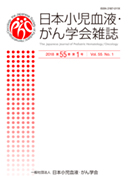Volume 55, Issue 1
Displaying 1-16 of 16 articles from this issue
- |<
- <
- 1
- >
- >|
JSPHO News
-
2018Volume 55Issue 1 Pages n55-1_1-n55-1_2
Published: 2018
Released on J-STAGE: May 24, 2018
Download PDF (588K)
The 58th Annual Meeting of the Japanese Society of Pediatric Hematology / Oncology
-
2018Volume 55Issue 1 Pages 1-6
Published: 2018
Released on J-STAGE: June 19, 2018
Download PDF (11095K)
Original Article
-
2018Volume 55Issue 1 Pages 7-14
Published: 2018
Released on J-STAGE: June 19, 2018
Download PDF (869K)
Case Report
-
2018Volume 55Issue 1 Pages 15-18
Published: 2018
Released on J-STAGE: June 19, 2018
Download PDF (938K) -
2018Volume 55Issue 1 Pages 19-22
Published: 2018
Released on J-STAGE: June 19, 2018
Download PDF (1021K) -
2018Volume 55Issue 1 Pages 23-27
Published: 2018
Released on J-STAGE: June 19, 2018
Download PDF (842K) -
2018Volume 55Issue 1 Pages 28-32
Published: 2018
Released on J-STAGE: June 19, 2018
Download PDF (6071K) -
2018Volume 55Issue 1 Pages 33-36
Published: 2018
Released on J-STAGE: June 19, 2018
Download PDF (2789K) -
2018Volume 55Issue 1 Pages 37-40
Published: 2018
Released on J-STAGE: June 19, 2018
Download PDF (2248K)
Report
-
2018Volume 55Issue 1 Pages 41-52
Published: 2018
Released on J-STAGE: June 19, 2018
Download PDF (987K) -
2018Volume 55Issue 1 Pages 53-66
Published: 2018
Released on J-STAGE: June 19, 2018
Download PDF (1044K) -
2018Volume 55Issue 1 Pages 67-70
Published: 2018
Released on J-STAGE: June 19, 2018
Download PDF (789K) -
2018Volume 55Issue 1 Pages 71-74
Published: 2018
Released on J-STAGE: June 19, 2018
Download PDF (725K) -
2018Volume 55Issue 1 Pages 75-76
Published: 2018
Released on J-STAGE: June 19, 2018
Download PDF (665K) -
2018Volume 55Issue 1 Pages 77-81
Published: 2018
Released on J-STAGE: June 19, 2018
Download PDF (846K) -
2018Volume 55Issue 1 Pages 83-106
Published: 2018
Released on J-STAGE: June 19, 2018
Download PDF (14255K)
- |<
- <
- 1
- >
- >|
